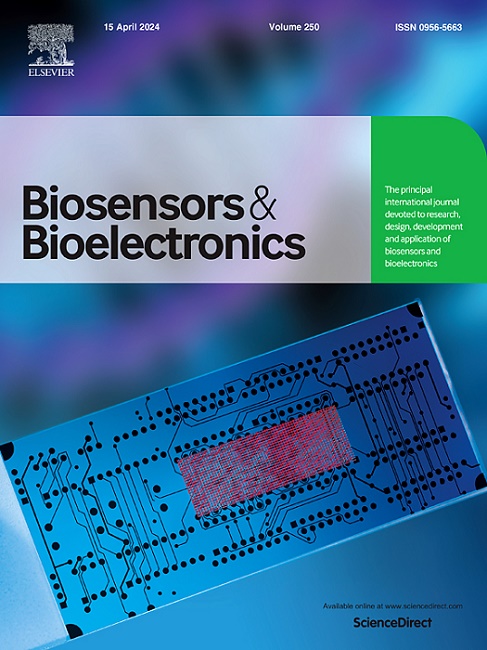在微流控芯片上使用时间-空间转换策略灵敏检测流感病毒的时间分辨发光试验
IF 10.5
1区 生物学
Q1 BIOPHYSICS
引用次数: 0
摘要
时间分辨发光法通过消除背景信号干扰,提高了检测灵敏度。然而,它通常需要昂贵而笨重的仪器,配备脉冲光源和高速光电探测器。本研究利用微流控芯片上的时空转换策略,开发了一种简单的时间分辨发光检测方法,实现了用小型、低成本设备对流感病毒核酸的灵敏检测。该方法将两根平行光纤集成到微流体通道中,用于激发和收集发光信号。磁分离后,用时间分辨发光探针标记的流感病毒核酸在层流条件下通过光纤时受到脉冲状光激发。随后,采用时间-空间转换策略,将探针移动到固定距离的第二根光纤,测量激发态发光强度随时间的变化。该检测策略避免了昂贵而复杂的脉冲激发光源和高速探测器。同时,它有一个简单的光学系统,每个微流控芯片的成本只有0.069美元。该方法通过消除本底自身荧光干扰,实现了流感病毒的超灵敏检测,检测限为54 pM,线性范围为0.1 ~ 100 nM。该方法在复杂样品中具有良好的特异性、重复性和抗干扰能力。因此,该方法在使用时间分辨发光分析的护理点检测中显示出显著的潜力。本文章由计算机程序翻译,如有差异,请以英文原文为准。

A time-resolved luminescence assay using time-to-space conversion strategy for the sensitive detection of influenza virus on a microfluidic chip
Time-resolved luminescence assay improves detection sensitivity through eliminating background signal interference. However, it typically requires expensive and bulky instruments equipped with a pulsed light source and high-speed photodetectors. Here, we developed a simple time-resolved luminescence detection method using time-to-space conversion strategy on the microfluidic chip, enabling the sensitive detection of influenza virus nucleic acid with miniature and low costs equipment. This approach integrated two parallel optical fibers into the microfluidic channel, serving to excite and collect luminescence signals. After magnetic separation, the influenza virus nucleic acid labeled with a time-resolved luminescence probe was subjected to pulsed-like photoexcitation when the probes passed through the optical fiber under laminar flow conditions. Subsequently, the excited-state luminescence intensity varying over time was measured as probes were moved to a second fiber at a fixed distance, employing the time-to-space conversion strategy. This detection strategy avoided expensive and complex pulsed excitation light source and high-speed detectors. Meanwhile, it had a simple optical system and a low cost of just 0.069 dollar per microfluidic chip. This method achieved ultrasensitive detection of influenza virus by eliminating background autofluorescence interference, with a detection limitation of 54 pM and a wide linear range from 0.1 nM to 100 nM. Moreover, this method showed good specificity, reproducibility and anti-interference ability in complex sample. Therefore, this method demonstrates significant potential in point-of-care detection by using time-resolved luminescence assay.
求助全文
通过发布文献求助,成功后即可免费获取论文全文。
去求助
来源期刊

Biosensors and Bioelectronics
工程技术-电化学
CiteScore
20.80
自引率
7.10%
发文量
1006
审稿时长
29 days
期刊介绍:
Biosensors & Bioelectronics, along with its open access companion journal Biosensors & Bioelectronics: X, is the leading international publication in the field of biosensors and bioelectronics. It covers research, design, development, and application of biosensors, which are analytical devices incorporating biological materials with physicochemical transducers. These devices, including sensors, DNA chips, electronic noses, and lab-on-a-chip, produce digital signals proportional to specific analytes. Examples include immunosensors and enzyme-based biosensors, applied in various fields such as medicine, environmental monitoring, and food industry. The journal also focuses on molecular and supramolecular structures for enhancing device performance.
 求助内容:
求助内容: 应助结果提醒方式:
应助结果提醒方式:


